Australian Law Assignment: Litigation, ADR, and Conflict Resolution
VerifiedAdded on 2022/08/19
|9
|3236
|10
Essay
AI Summary
This essay delves into the contrasting approaches of litigation and alternative dispute resolution (ADR) within the Australian legal framework. It begins by defining conflict and exploring the traditional method of litigation, outlining the structure of Australian courts and the procedures involved. The essay then details the advantages of litigation, such as the creation of public records and the provision of legal precedents, while also acknowledging its disadvantages, including high costs and delays. Subsequently, the essay shifts its focus to ADR, defining its various forms like arbitration and mediation, and highlighting its characteristics such as a focus on parties' relationships and a less formal structure. The benefits of ADR, including greater party control and potential for lasting agreements, are discussed, as well as its potential drawbacks. The essay aims to compare and contrast these two methods, analyzing their respective strengths and weaknesses in resolving disputes within the Australian context.
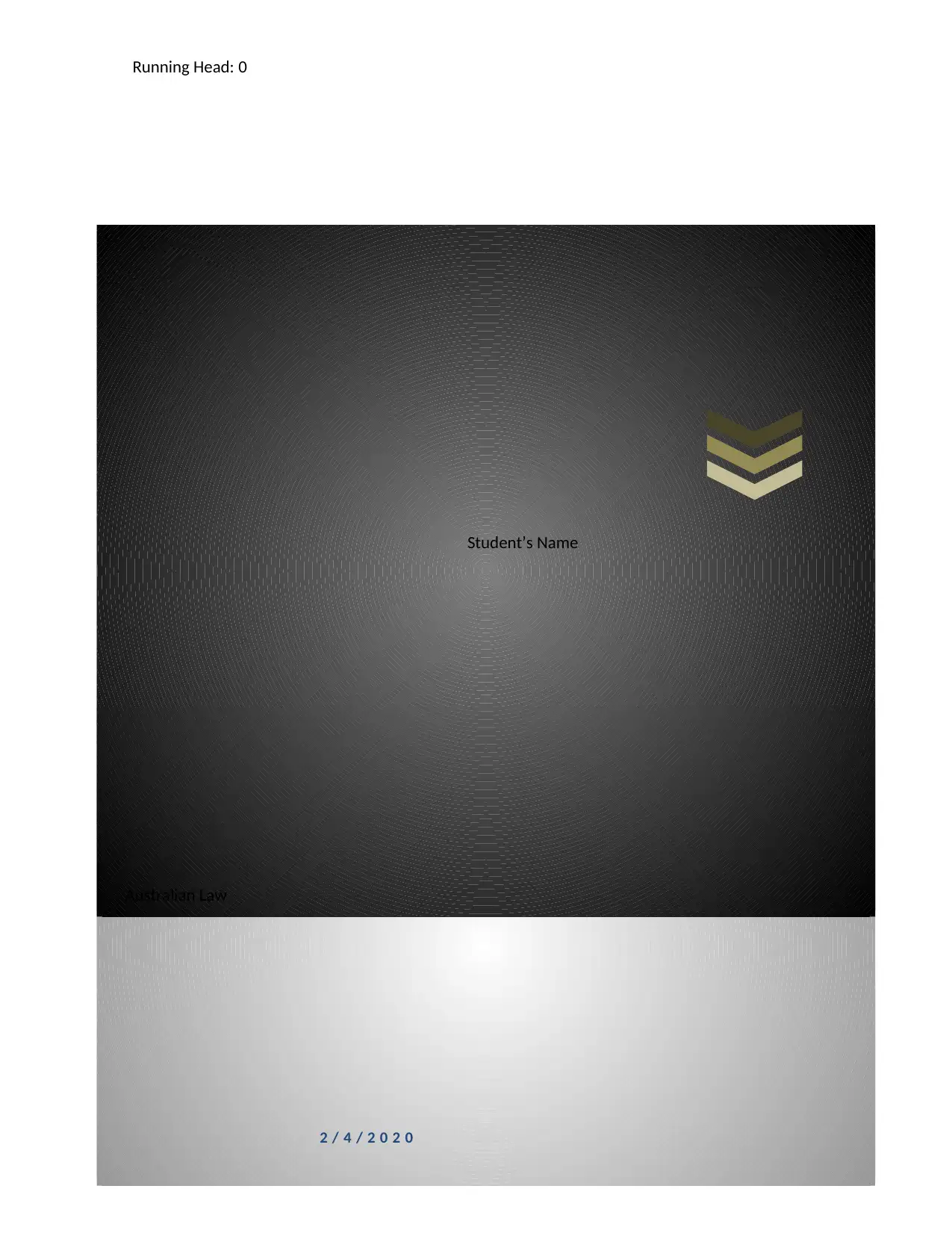
Australian Law
Running Head: 0
2 / 4 / 2 0 2 0
Student’s Name
Running Head: 0
2 / 4 / 2 0 2 0
Student’s Name
Paraphrase This Document
Need a fresh take? Get an instant paraphrase of this document with our AI Paraphraser
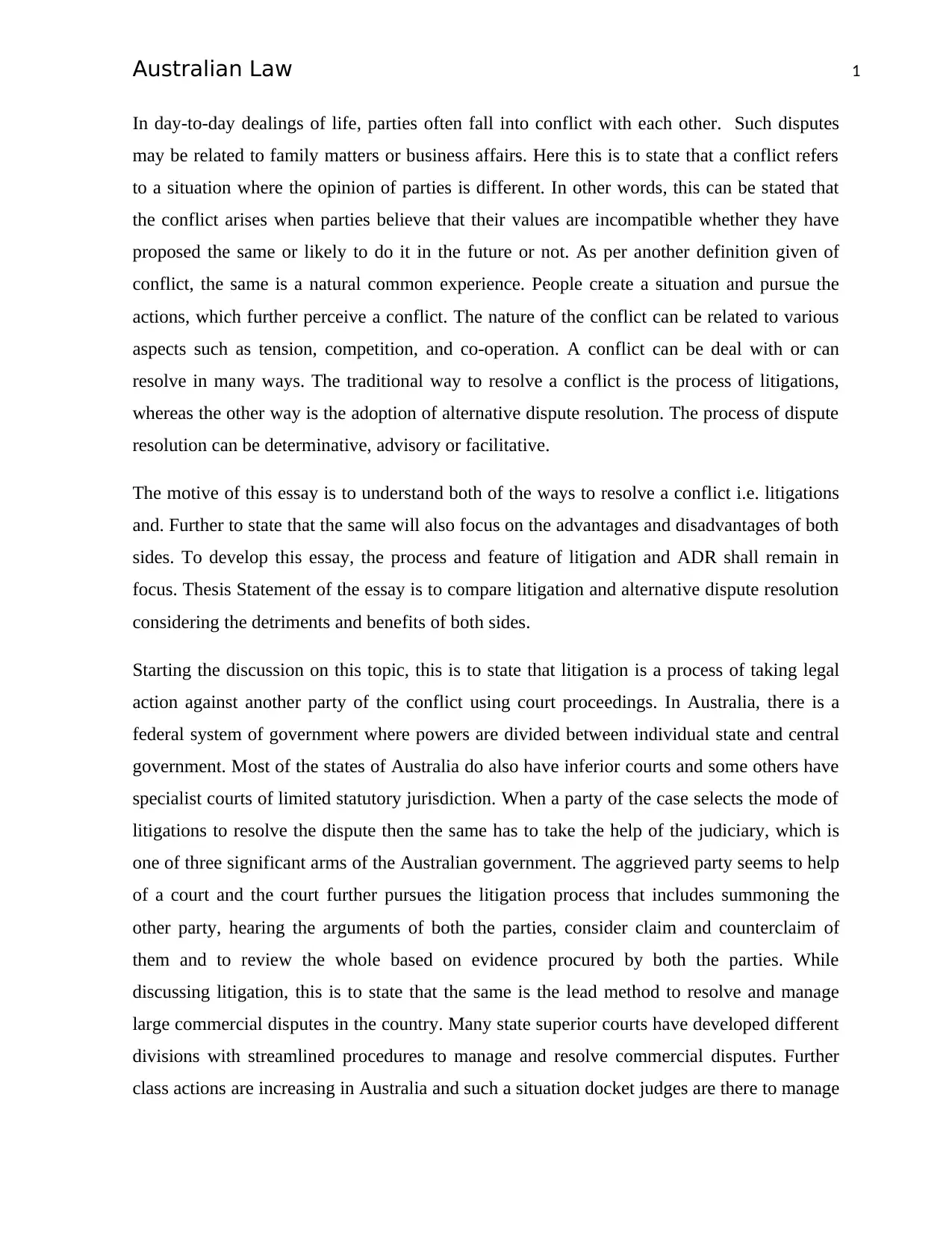
Australian Law 1
In day-to-day dealings of life, parties often fall into conflict with each other. Such disputes
may be related to family matters or business affairs. Here this is to state that a conflict refers
to a situation where the opinion of parties is different. In other words, this can be stated that
the conflict arises when parties believe that their values are incompatible whether they have
proposed the same or likely to do it in the future or not. As per another definition given of
conflict, the same is a natural common experience. People create a situation and pursue the
actions, which further perceive a conflict. The nature of the conflict can be related to various
aspects such as tension, competition, and co-operation. A conflict can be deal with or can
resolve in many ways. The traditional way to resolve a conflict is the process of litigations,
whereas the other way is the adoption of alternative dispute resolution. The process of dispute
resolution can be determinative, advisory or facilitative.
The motive of this essay is to understand both of the ways to resolve a conflict i.e. litigations
and. Further to state that the same will also focus on the advantages and disadvantages of both
sides. To develop this essay, the process and feature of litigation and ADR shall remain in
focus. Thesis Statement of the essay is to compare litigation and alternative dispute resolution
considering the detriments and benefits of both sides.
Starting the discussion on this topic, this is to state that litigation is a process of taking legal
action against another party of the conflict using court proceedings. In Australia, there is a
federal system of government where powers are divided between individual state and central
government. Most of the states of Australia do also have inferior courts and some others have
specialist courts of limited statutory jurisdiction. When a party of the case selects the mode of
litigations to resolve the dispute then the same has to take the help of the judiciary, which is
one of three significant arms of the Australian government. The aggrieved party seems to help
of a court and the court further pursues the litigation process that includes summoning the
other party, hearing the arguments of both the parties, consider claim and counterclaim of
them and to review the whole based on evidence procured by both the parties. While
discussing litigation, this is to state that the same is the lead method to resolve and manage
large commercial disputes in the country. Many state superior courts have developed different
divisions with streamlined procedures to manage and resolve commercial disputes. Further
class actions are increasing in Australia and such a situation docket judges are there to manage
In day-to-day dealings of life, parties often fall into conflict with each other. Such disputes
may be related to family matters or business affairs. Here this is to state that a conflict refers
to a situation where the opinion of parties is different. In other words, this can be stated that
the conflict arises when parties believe that their values are incompatible whether they have
proposed the same or likely to do it in the future or not. As per another definition given of
conflict, the same is a natural common experience. People create a situation and pursue the
actions, which further perceive a conflict. The nature of the conflict can be related to various
aspects such as tension, competition, and co-operation. A conflict can be deal with or can
resolve in many ways. The traditional way to resolve a conflict is the process of litigations,
whereas the other way is the adoption of alternative dispute resolution. The process of dispute
resolution can be determinative, advisory or facilitative.
The motive of this essay is to understand both of the ways to resolve a conflict i.e. litigations
and. Further to state that the same will also focus on the advantages and disadvantages of both
sides. To develop this essay, the process and feature of litigation and ADR shall remain in
focus. Thesis Statement of the essay is to compare litigation and alternative dispute resolution
considering the detriments and benefits of both sides.
Starting the discussion on this topic, this is to state that litigation is a process of taking legal
action against another party of the conflict using court proceedings. In Australia, there is a
federal system of government where powers are divided between individual state and central
government. Most of the states of Australia do also have inferior courts and some others have
specialist courts of limited statutory jurisdiction. When a party of the case selects the mode of
litigations to resolve the dispute then the same has to take the help of the judiciary, which is
one of three significant arms of the Australian government. The aggrieved party seems to help
of a court and the court further pursues the litigation process that includes summoning the
other party, hearing the arguments of both the parties, consider claim and counterclaim of
them and to review the whole based on evidence procured by both the parties. While
discussing litigation, this is to state that the same is the lead method to resolve and manage
large commercial disputes in the country. Many state superior courts have developed different
divisions with streamlined procedures to manage and resolve commercial disputes. Further
class actions are increasing in Australia and such a situation docket judges are there to manage
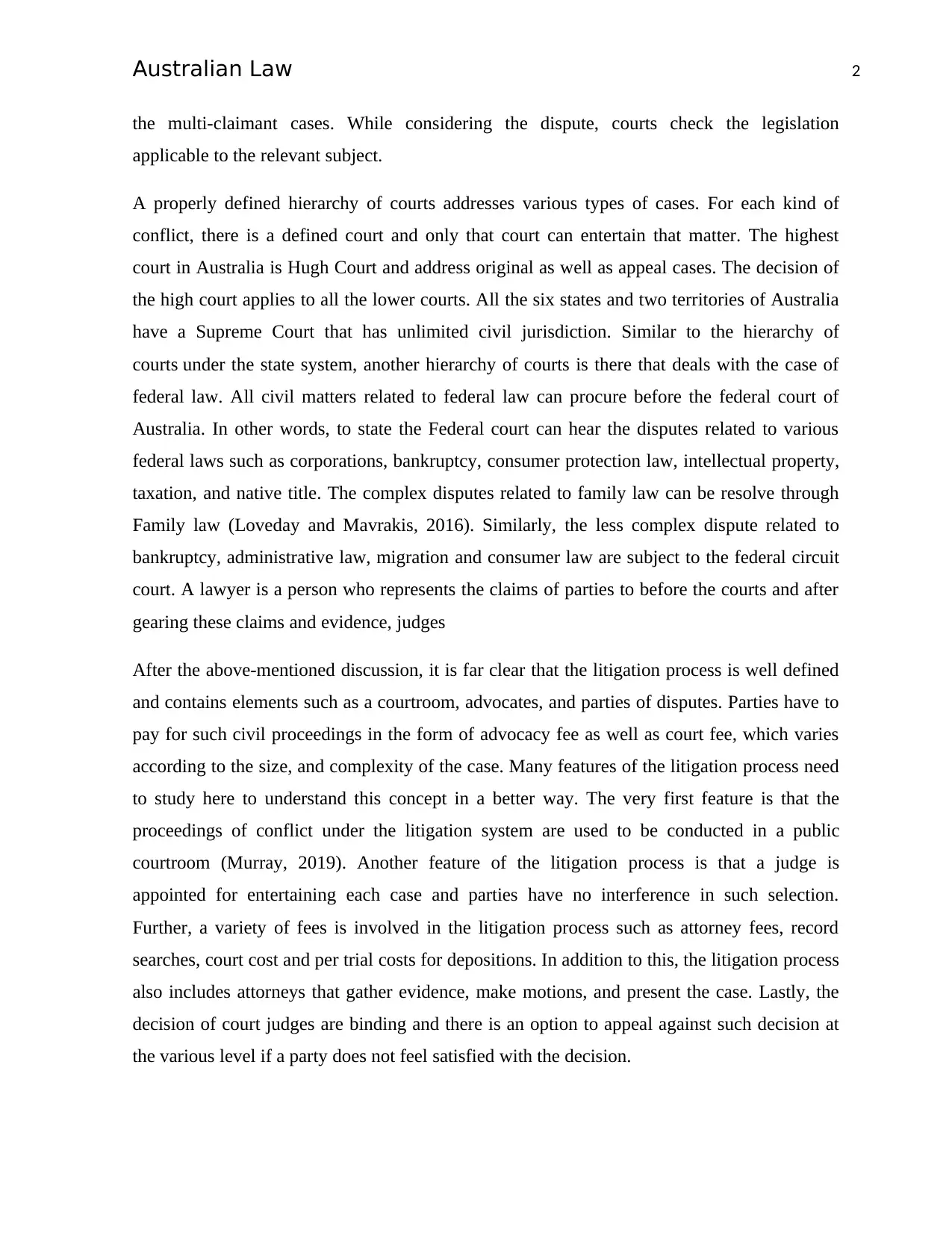
Australian Law 2
the multi-claimant cases. While considering the dispute, courts check the legislation
applicable to the relevant subject.
A properly defined hierarchy of courts addresses various types of cases. For each kind of
conflict, there is a defined court and only that court can entertain that matter. The highest
court in Australia is Hugh Court and address original as well as appeal cases. The decision of
the high court applies to all the lower courts. All the six states and two territories of Australia
have a Supreme Court that has unlimited civil jurisdiction. Similar to the hierarchy of
courts under the state system, another hierarchy of courts is there that deals with the case of
federal law. All civil matters related to federal law can procure before the federal court of
Australia. In other words, to state the Federal court can hear the disputes related to various
federal laws such as corporations, bankruptcy, consumer protection law, intellectual property,
taxation, and native title. The complex disputes related to family law can be resolve through
Family law (Loveday and Mavrakis, 2016). Similarly, the less complex dispute related to
bankruptcy, administrative law, migration and consumer law are subject to the federal circuit
court. A lawyer is a person who represents the claims of parties to before the courts and after
gearing these claims and evidence, judges
After the above-mentioned discussion, it is far clear that the litigation process is well defined
and contains elements such as a courtroom, advocates, and parties of disputes. Parties have to
pay for such civil proceedings in the form of advocacy fee as well as court fee, which varies
according to the size, and complexity of the case. Many features of the litigation process need
to study here to understand this concept in a better way. The very first feature is that the
proceedings of conflict under the litigation system are used to be conducted in a public
courtroom (Murray, 2019). Another feature of the litigation process is that a judge is
appointed for entertaining each case and parties have no interference in such selection.
Further, a variety of fees is involved in the litigation process such as attorney fees, record
searches, court cost and per trial costs for depositions. In addition to this, the litigation process
also includes attorneys that gather evidence, make motions, and present the case. Lastly, the
decision of court judges are binding and there is an option to appeal against such decision at
the various level if a party does not feel satisfied with the decision.
the multi-claimant cases. While considering the dispute, courts check the legislation
applicable to the relevant subject.
A properly defined hierarchy of courts addresses various types of cases. For each kind of
conflict, there is a defined court and only that court can entertain that matter. The highest
court in Australia is Hugh Court and address original as well as appeal cases. The decision of
the high court applies to all the lower courts. All the six states and two territories of Australia
have a Supreme Court that has unlimited civil jurisdiction. Similar to the hierarchy of
courts under the state system, another hierarchy of courts is there that deals with the case of
federal law. All civil matters related to federal law can procure before the federal court of
Australia. In other words, to state the Federal court can hear the disputes related to various
federal laws such as corporations, bankruptcy, consumer protection law, intellectual property,
taxation, and native title. The complex disputes related to family law can be resolve through
Family law (Loveday and Mavrakis, 2016). Similarly, the less complex dispute related to
bankruptcy, administrative law, migration and consumer law are subject to the federal circuit
court. A lawyer is a person who represents the claims of parties to before the courts and after
gearing these claims and evidence, judges
After the above-mentioned discussion, it is far clear that the litigation process is well defined
and contains elements such as a courtroom, advocates, and parties of disputes. Parties have to
pay for such civil proceedings in the form of advocacy fee as well as court fee, which varies
according to the size, and complexity of the case. Many features of the litigation process need
to study here to understand this concept in a better way. The very first feature is that the
proceedings of conflict under the litigation system are used to be conducted in a public
courtroom (Murray, 2019). Another feature of the litigation process is that a judge is
appointed for entertaining each case and parties have no interference in such selection.
Further, a variety of fees is involved in the litigation process such as attorney fees, record
searches, court cost and per trial costs for depositions. In addition to this, the litigation process
also includes attorneys that gather evidence, make motions, and present the case. Lastly, the
decision of court judges are binding and there is an option to appeal against such decision at
the various level if a party does not feel satisfied with the decision.
⊘ This is a preview!⊘
Do you want full access?
Subscribe today to unlock all pages.

Trusted by 1+ million students worldwide
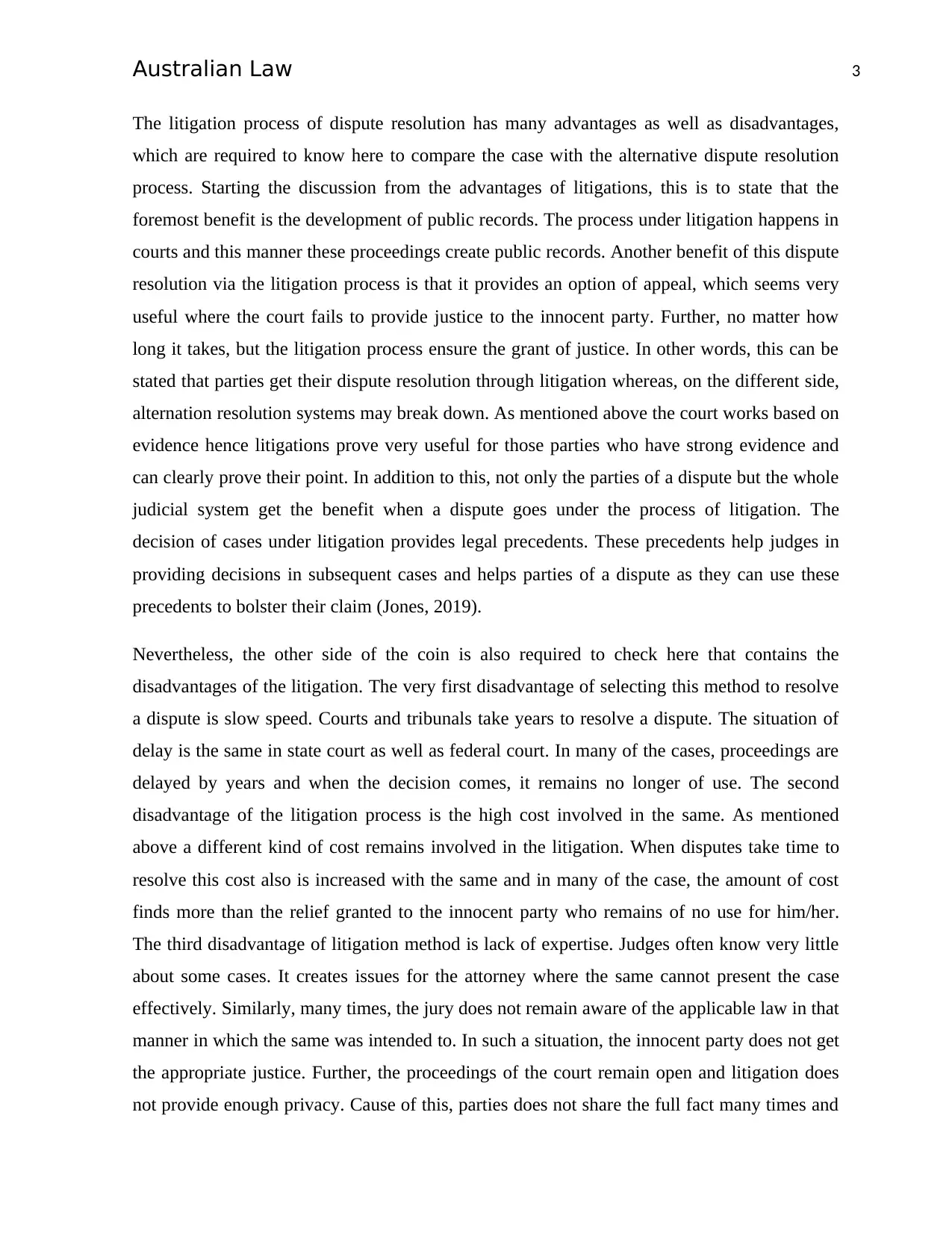
Australian Law 3
The litigation process of dispute resolution has many advantages as well as disadvantages,
which are required to know here to compare the case with the alternative dispute resolution
process. Starting the discussion from the advantages of litigations, this is to state that the
foremost benefit is the development of public records. The process under litigation happens in
courts and this manner these proceedings create public records. Another benefit of this dispute
resolution via the litigation process is that it provides an option of appeal, which seems very
useful where the court fails to provide justice to the innocent party. Further, no matter how
long it takes, but the litigation process ensure the grant of justice. In other words, this can be
stated that parties get their dispute resolution through litigation whereas, on the different side,
alternation resolution systems may break down. As mentioned above the court works based on
evidence hence litigations prove very useful for those parties who have strong evidence and
can clearly prove their point. In addition to this, not only the parties of a dispute but the whole
judicial system get the benefit when a dispute goes under the process of litigation. The
decision of cases under litigation provides legal precedents. These precedents help judges in
providing decisions in subsequent cases and helps parties of a dispute as they can use these
precedents to bolster their claim (Jones, 2019).
Nevertheless, the other side of the coin is also required to check here that contains the
disadvantages of the litigation. The very first disadvantage of selecting this method to resolve
a dispute is slow speed. Courts and tribunals take years to resolve a dispute. The situation of
delay is the same in state court as well as federal court. In many of the cases, proceedings are
delayed by years and when the decision comes, it remains no longer of use. The second
disadvantage of the litigation process is the high cost involved in the same. As mentioned
above a different kind of cost remains involved in the litigation. When disputes take time to
resolve this cost also is increased with the same and in many of the case, the amount of cost
finds more than the relief granted to the innocent party who remains of no use for him/her.
The third disadvantage of litigation method is lack of expertise. Judges often know very little
about some cases. It creates issues for the attorney where the same cannot present the case
effectively. Similarly, many times, the jury does not remain aware of the applicable law in that
manner in which the same was intended to. In such a situation, the innocent party does not get
the appropriate justice. Further, the proceedings of the court remain open and litigation does
not provide enough privacy. Cause of this, parties does not share the full fact many times and
The litigation process of dispute resolution has many advantages as well as disadvantages,
which are required to know here to compare the case with the alternative dispute resolution
process. Starting the discussion from the advantages of litigations, this is to state that the
foremost benefit is the development of public records. The process under litigation happens in
courts and this manner these proceedings create public records. Another benefit of this dispute
resolution via the litigation process is that it provides an option of appeal, which seems very
useful where the court fails to provide justice to the innocent party. Further, no matter how
long it takes, but the litigation process ensure the grant of justice. In other words, this can be
stated that parties get their dispute resolution through litigation whereas, on the different side,
alternation resolution systems may break down. As mentioned above the court works based on
evidence hence litigations prove very useful for those parties who have strong evidence and
can clearly prove their point. In addition to this, not only the parties of a dispute but the whole
judicial system get the benefit when a dispute goes under the process of litigation. The
decision of cases under litigation provides legal precedents. These precedents help judges in
providing decisions in subsequent cases and helps parties of a dispute as they can use these
precedents to bolster their claim (Jones, 2019).
Nevertheless, the other side of the coin is also required to check here that contains the
disadvantages of the litigation. The very first disadvantage of selecting this method to resolve
a dispute is slow speed. Courts and tribunals take years to resolve a dispute. The situation of
delay is the same in state court as well as federal court. In many of the cases, proceedings are
delayed by years and when the decision comes, it remains no longer of use. The second
disadvantage of the litigation process is the high cost involved in the same. As mentioned
above a different kind of cost remains involved in the litigation. When disputes take time to
resolve this cost also is increased with the same and in many of the case, the amount of cost
finds more than the relief granted to the innocent party who remains of no use for him/her.
The third disadvantage of litigation method is lack of expertise. Judges often know very little
about some cases. It creates issues for the attorney where the same cannot present the case
effectively. Similarly, many times, the jury does not remain aware of the applicable law in that
manner in which the same was intended to. In such a situation, the innocent party does not get
the appropriate justice. Further, the proceedings of the court remain open and litigation does
not provide enough privacy. Cause of this, parties does not share the full fact many times and
Paraphrase This Document
Need a fresh take? Get an instant paraphrase of this document with our AI Paraphraser
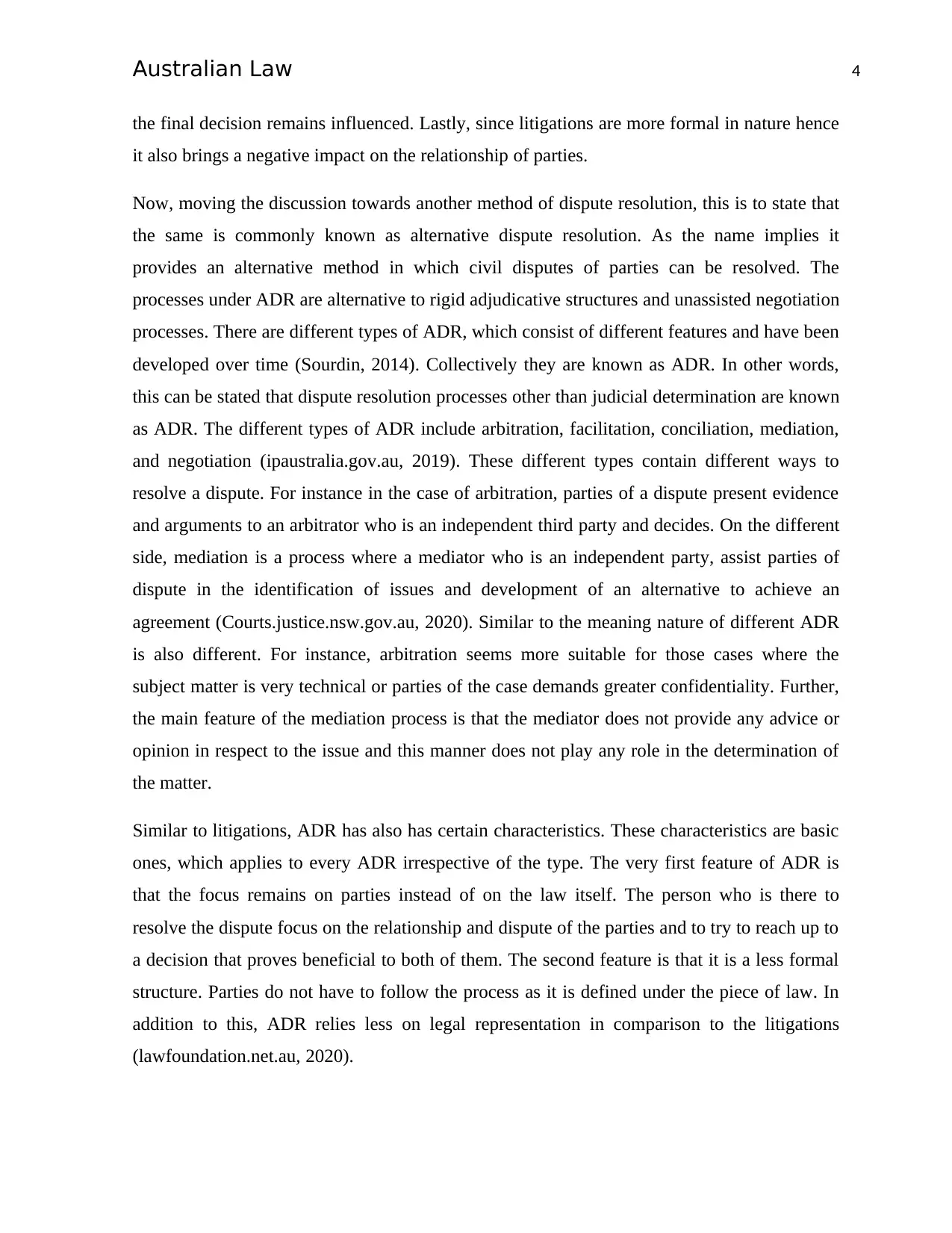
Australian Law 4
the final decision remains influenced. Lastly, since litigations are more formal in nature hence
it also brings a negative impact on the relationship of parties.
Now, moving the discussion towards another method of dispute resolution, this is to state that
the same is commonly known as alternative dispute resolution. As the name implies it
provides an alternative method in which civil disputes of parties can be resolved. The
processes under ADR are alternative to rigid adjudicative structures and unassisted negotiation
processes. There are different types of ADR, which consist of different features and have been
developed over time (Sourdin, 2014). Collectively they are known as ADR. In other words,
this can be stated that dispute resolution processes other than judicial determination are known
as ADR. The different types of ADR include arbitration, facilitation, conciliation, mediation,
and negotiation (ipaustralia.gov.au, 2019). These different types contain different ways to
resolve a dispute. For instance in the case of arbitration, parties of a dispute present evidence
and arguments to an arbitrator who is an independent third party and decides. On the different
side, mediation is a process where a mediator who is an independent party, assist parties of
dispute in the identification of issues and development of an alternative to achieve an
agreement (Courts.justice.nsw.gov.au, 2020). Similar to the meaning nature of different ADR
is also different. For instance, arbitration seems more suitable for those cases where the
subject matter is very technical or parties of the case demands greater confidentiality. Further,
the main feature of the mediation process is that the mediator does not provide any advice or
opinion in respect to the issue and this manner does not play any role in the determination of
the matter.
Similar to litigations, ADR has also has certain characteristics. These characteristics are basic
ones, which applies to every ADR irrespective of the type. The very first feature of ADR is
that the focus remains on parties instead of on the law itself. The person who is there to
resolve the dispute focus on the relationship and dispute of the parties and to try to reach up to
a decision that proves beneficial to both of them. The second feature is that it is a less formal
structure. Parties do not have to follow the process as it is defined under the piece of law. In
addition to this, ADR relies less on legal representation in comparison to the litigations
(lawfoundation.net.au, 2020).
the final decision remains influenced. Lastly, since litigations are more formal in nature hence
it also brings a negative impact on the relationship of parties.
Now, moving the discussion towards another method of dispute resolution, this is to state that
the same is commonly known as alternative dispute resolution. As the name implies it
provides an alternative method in which civil disputes of parties can be resolved. The
processes under ADR are alternative to rigid adjudicative structures and unassisted negotiation
processes. There are different types of ADR, which consist of different features and have been
developed over time (Sourdin, 2014). Collectively they are known as ADR. In other words,
this can be stated that dispute resolution processes other than judicial determination are known
as ADR. The different types of ADR include arbitration, facilitation, conciliation, mediation,
and negotiation (ipaustralia.gov.au, 2019). These different types contain different ways to
resolve a dispute. For instance in the case of arbitration, parties of a dispute present evidence
and arguments to an arbitrator who is an independent third party and decides. On the different
side, mediation is a process where a mediator who is an independent party, assist parties of
dispute in the identification of issues and development of an alternative to achieve an
agreement (Courts.justice.nsw.gov.au, 2020). Similar to the meaning nature of different ADR
is also different. For instance, arbitration seems more suitable for those cases where the
subject matter is very technical or parties of the case demands greater confidentiality. Further,
the main feature of the mediation process is that the mediator does not provide any advice or
opinion in respect to the issue and this manner does not play any role in the determination of
the matter.
Similar to litigations, ADR has also has certain characteristics. These characteristics are basic
ones, which applies to every ADR irrespective of the type. The very first feature of ADR is
that the focus remains on parties instead of on the law itself. The person who is there to
resolve the dispute focus on the relationship and dispute of the parties and to try to reach up to
a decision that proves beneficial to both of them. The second feature is that it is a less formal
structure. Parties do not have to follow the process as it is defined under the piece of law. In
addition to this, ADR relies less on legal representation in comparison to the litigations
(lawfoundation.net.au, 2020).
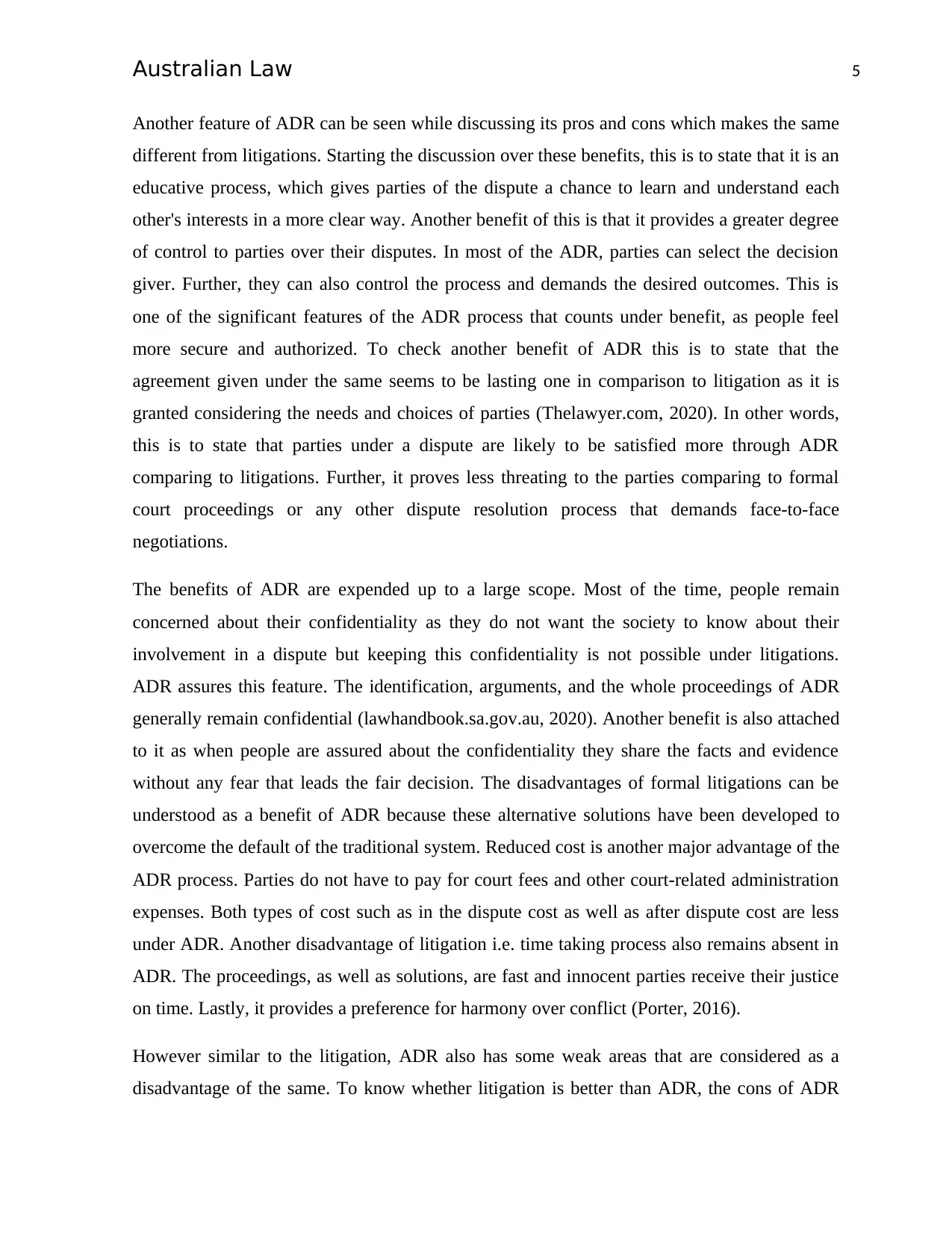
Australian Law 5
Another feature of ADR can be seen while discussing its pros and cons which makes the same
different from litigations. Starting the discussion over these benefits, this is to state that it is an
educative process, which gives parties of the dispute a chance to learn and understand each
other's interests in a more clear way. Another benefit of this is that it provides a greater degree
of control to parties over their disputes. In most of the ADR, parties can select the decision
giver. Further, they can also control the process and demands the desired outcomes. This is
one of the significant features of the ADR process that counts under benefit, as people feel
more secure and authorized. To check another benefit of ADR this is to state that the
agreement given under the same seems to be lasting one in comparison to litigation as it is
granted considering the needs and choices of parties (Thelawyer.com, 2020). In other words,
this is to state that parties under a dispute are likely to be satisfied more through ADR
comparing to litigations. Further, it proves less threating to the parties comparing to formal
court proceedings or any other dispute resolution process that demands face-to-face
negotiations.
The benefits of ADR are expended up to a large scope. Most of the time, people remain
concerned about their confidentiality as they do not want the society to know about their
involvement in a dispute but keeping this confidentiality is not possible under litigations.
ADR assures this feature. The identification, arguments, and the whole proceedings of ADR
generally remain confidential (lawhandbook.sa.gov.au, 2020). Another benefit is also attached
to it as when people are assured about the confidentiality they share the facts and evidence
without any fear that leads the fair decision. The disadvantages of formal litigations can be
understood as a benefit of ADR because these alternative solutions have been developed to
overcome the default of the traditional system. Reduced cost is another major advantage of the
ADR process. Parties do not have to pay for court fees and other court-related administration
expenses. Both types of cost such as in the dispute cost as well as after dispute cost are less
under ADR. Another disadvantage of litigation i.e. time taking process also remains absent in
ADR. The proceedings, as well as solutions, are fast and innocent parties receive their justice
on time. Lastly, it provides a preference for harmony over conflict (Porter, 2016).
However similar to the litigation, ADR also has some weak areas that are considered as a
disadvantage of the same. To know whether litigation is better than ADR, the cons of ADR
Another feature of ADR can be seen while discussing its pros and cons which makes the same
different from litigations. Starting the discussion over these benefits, this is to state that it is an
educative process, which gives parties of the dispute a chance to learn and understand each
other's interests in a more clear way. Another benefit of this is that it provides a greater degree
of control to parties over their disputes. In most of the ADR, parties can select the decision
giver. Further, they can also control the process and demands the desired outcomes. This is
one of the significant features of the ADR process that counts under benefit, as people feel
more secure and authorized. To check another benefit of ADR this is to state that the
agreement given under the same seems to be lasting one in comparison to litigation as it is
granted considering the needs and choices of parties (Thelawyer.com, 2020). In other words,
this is to state that parties under a dispute are likely to be satisfied more through ADR
comparing to litigations. Further, it proves less threating to the parties comparing to formal
court proceedings or any other dispute resolution process that demands face-to-face
negotiations.
The benefits of ADR are expended up to a large scope. Most of the time, people remain
concerned about their confidentiality as they do not want the society to know about their
involvement in a dispute but keeping this confidentiality is not possible under litigations.
ADR assures this feature. The identification, arguments, and the whole proceedings of ADR
generally remain confidential (lawhandbook.sa.gov.au, 2020). Another benefit is also attached
to it as when people are assured about the confidentiality they share the facts and evidence
without any fear that leads the fair decision. The disadvantages of formal litigations can be
understood as a benefit of ADR because these alternative solutions have been developed to
overcome the default of the traditional system. Reduced cost is another major advantage of the
ADR process. Parties do not have to pay for court fees and other court-related administration
expenses. Both types of cost such as in the dispute cost as well as after dispute cost are less
under ADR. Another disadvantage of litigation i.e. time taking process also remains absent in
ADR. The proceedings, as well as solutions, are fast and innocent parties receive their justice
on time. Lastly, it provides a preference for harmony over conflict (Porter, 2016).
However similar to the litigation, ADR also has some weak areas that are considered as a
disadvantage of the same. To know whether litigation is better than ADR, the cons of ADR
⊘ This is a preview!⊘
Do you want full access?
Subscribe today to unlock all pages.

Trusted by 1+ million students worldwide
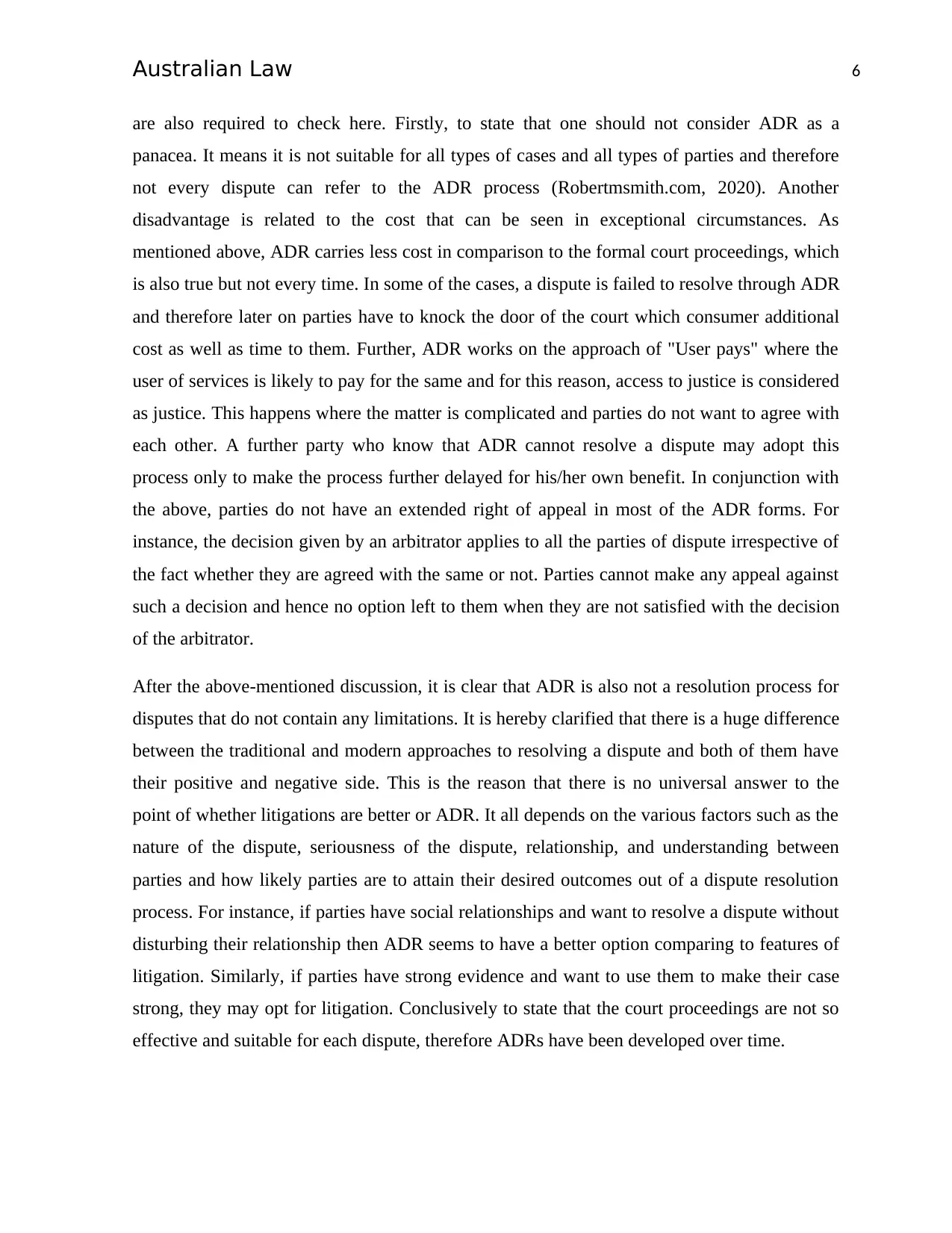
Australian Law 6
are also required to check here. Firstly, to state that one should not consider ADR as a
panacea. It means it is not suitable for all types of cases and all types of parties and therefore
not every dispute can refer to the ADR process (Robertmsmith.com, 2020). Another
disadvantage is related to the cost that can be seen in exceptional circumstances. As
mentioned above, ADR carries less cost in comparison to the formal court proceedings, which
is also true but not every time. In some of the cases, a dispute is failed to resolve through ADR
and therefore later on parties have to knock the door of the court which consumer additional
cost as well as time to them. Further, ADR works on the approach of "User pays" where the
user of services is likely to pay for the same and for this reason, access to justice is considered
as justice. This happens where the matter is complicated and parties do not want to agree with
each other. A further party who know that ADR cannot resolve a dispute may adopt this
process only to make the process further delayed for his/her own benefit. In conjunction with
the above, parties do not have an extended right of appeal in most of the ADR forms. For
instance, the decision given by an arbitrator applies to all the parties of dispute irrespective of
the fact whether they are agreed with the same or not. Parties cannot make any appeal against
such a decision and hence no option left to them when they are not satisfied with the decision
of the arbitrator.
After the above-mentioned discussion, it is clear that ADR is also not a resolution process for
disputes that do not contain any limitations. It is hereby clarified that there is a huge difference
between the traditional and modern approaches to resolving a dispute and both of them have
their positive and negative side. This is the reason that there is no universal answer to the
point of whether litigations are better or ADR. It all depends on the various factors such as the
nature of the dispute, seriousness of the dispute, relationship, and understanding between
parties and how likely parties are to attain their desired outcomes out of a dispute resolution
process. For instance, if parties have social relationships and want to resolve a dispute without
disturbing their relationship then ADR seems to have a better option comparing to features of
litigation. Similarly, if parties have strong evidence and want to use them to make their case
strong, they may opt for litigation. Conclusively to state that the court proceedings are not so
effective and suitable for each dispute, therefore ADRs have been developed over time.
are also required to check here. Firstly, to state that one should not consider ADR as a
panacea. It means it is not suitable for all types of cases and all types of parties and therefore
not every dispute can refer to the ADR process (Robertmsmith.com, 2020). Another
disadvantage is related to the cost that can be seen in exceptional circumstances. As
mentioned above, ADR carries less cost in comparison to the formal court proceedings, which
is also true but not every time. In some of the cases, a dispute is failed to resolve through ADR
and therefore later on parties have to knock the door of the court which consumer additional
cost as well as time to them. Further, ADR works on the approach of "User pays" where the
user of services is likely to pay for the same and for this reason, access to justice is considered
as justice. This happens where the matter is complicated and parties do not want to agree with
each other. A further party who know that ADR cannot resolve a dispute may adopt this
process only to make the process further delayed for his/her own benefit. In conjunction with
the above, parties do not have an extended right of appeal in most of the ADR forms. For
instance, the decision given by an arbitrator applies to all the parties of dispute irrespective of
the fact whether they are agreed with the same or not. Parties cannot make any appeal against
such a decision and hence no option left to them when they are not satisfied with the decision
of the arbitrator.
After the above-mentioned discussion, it is clear that ADR is also not a resolution process for
disputes that do not contain any limitations. It is hereby clarified that there is a huge difference
between the traditional and modern approaches to resolving a dispute and both of them have
their positive and negative side. This is the reason that there is no universal answer to the
point of whether litigations are better or ADR. It all depends on the various factors such as the
nature of the dispute, seriousness of the dispute, relationship, and understanding between
parties and how likely parties are to attain their desired outcomes out of a dispute resolution
process. For instance, if parties have social relationships and want to resolve a dispute without
disturbing their relationship then ADR seems to have a better option comparing to features of
litigation. Similarly, if parties have strong evidence and want to use them to make their case
strong, they may opt for litigation. Conclusively to state that the court proceedings are not so
effective and suitable for each dispute, therefore ADRs have been developed over time.
Paraphrase This Document
Need a fresh take? Get an instant paraphrase of this document with our AI Paraphraser
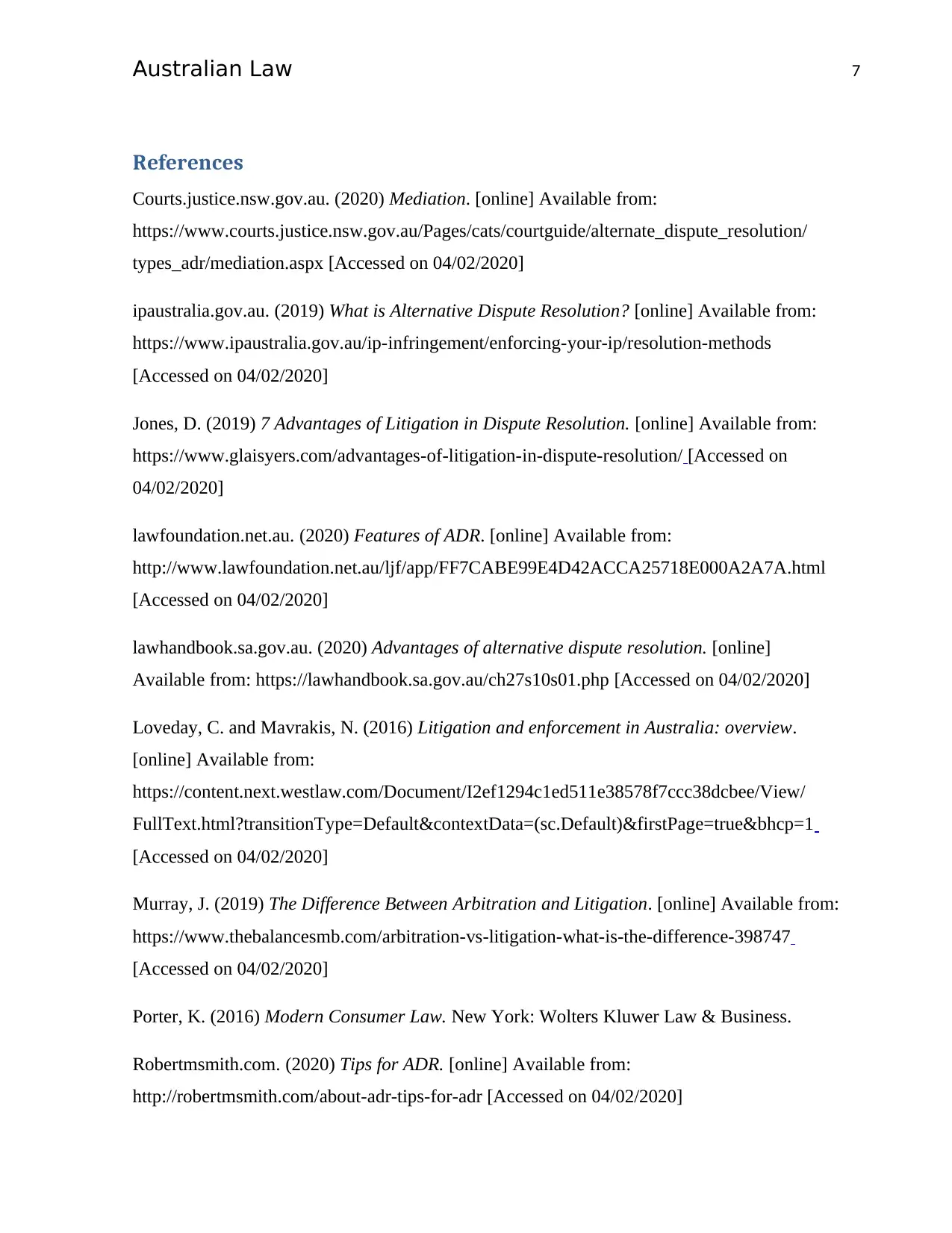
Australian Law 7
References
Courts.justice.nsw.gov.au. (2020) Mediation. [online] Available from:
https://www.courts.justice.nsw.gov.au/Pages/cats/courtguide/alternate_dispute_resolution/
types_adr/mediation.aspx [Accessed on 04/02/2020]
ipaustralia.gov.au. (2019) What is Alternative Dispute Resolution? [online] Available from:
https://www.ipaustralia.gov.au/ip-infringement/enforcing-your-ip/resolution-methods
[Accessed on 04/02/2020]
Jones, D. (2019) 7 Advantages of Litigation in Dispute Resolution. [online] Available from:
https://www.glaisyers.com/advantages-of-litigation-in-dispute-resolution/ [Accessed on
04/02/2020]
lawfoundation.net.au. (2020) Features of ADR. [online] Available from:
http://www.lawfoundation.net.au/ljf/app/FF7CABE99E4D42ACCA25718E000A2A7A.html
[Accessed on 04/02/2020]
lawhandbook.sa.gov.au. (2020) Advantages of alternative dispute resolution. [online]
Available from: https://lawhandbook.sa.gov.au/ch27s10s01.php [Accessed on 04/02/2020]
Loveday, C. and Mavrakis, N. (2016) Litigation and enforcement in Australia: overview.
[online] Available from:
https://content.next.westlaw.com/Document/I2ef1294c1ed511e38578f7ccc38dcbee/View/
FullText.html?transitionType=Default&contextData=(sc.Default)&firstPage=true&bhcp=1
[Accessed on 04/02/2020]
Murray, J. (2019) The Difference Between Arbitration and Litigation. [online] Available from:
https://www.thebalancesmb.com/arbitration-vs-litigation-what-is-the-difference-398747
[Accessed on 04/02/2020]
Porter, K. (2016) Modern Consumer Law. New York: Wolters Kluwer Law & Business.
Robertmsmith.com. (2020) Tips for ADR. [online] Available from:
http://robertmsmith.com/about-adr-tips-for-adr [Accessed on 04/02/2020]
References
Courts.justice.nsw.gov.au. (2020) Mediation. [online] Available from:
https://www.courts.justice.nsw.gov.au/Pages/cats/courtguide/alternate_dispute_resolution/
types_adr/mediation.aspx [Accessed on 04/02/2020]
ipaustralia.gov.au. (2019) What is Alternative Dispute Resolution? [online] Available from:
https://www.ipaustralia.gov.au/ip-infringement/enforcing-your-ip/resolution-methods
[Accessed on 04/02/2020]
Jones, D. (2019) 7 Advantages of Litigation in Dispute Resolution. [online] Available from:
https://www.glaisyers.com/advantages-of-litigation-in-dispute-resolution/ [Accessed on
04/02/2020]
lawfoundation.net.au. (2020) Features of ADR. [online] Available from:
http://www.lawfoundation.net.au/ljf/app/FF7CABE99E4D42ACCA25718E000A2A7A.html
[Accessed on 04/02/2020]
lawhandbook.sa.gov.au. (2020) Advantages of alternative dispute resolution. [online]
Available from: https://lawhandbook.sa.gov.au/ch27s10s01.php [Accessed on 04/02/2020]
Loveday, C. and Mavrakis, N. (2016) Litigation and enforcement in Australia: overview.
[online] Available from:
https://content.next.westlaw.com/Document/I2ef1294c1ed511e38578f7ccc38dcbee/View/
FullText.html?transitionType=Default&contextData=(sc.Default)&firstPage=true&bhcp=1
[Accessed on 04/02/2020]
Murray, J. (2019) The Difference Between Arbitration and Litigation. [online] Available from:
https://www.thebalancesmb.com/arbitration-vs-litigation-what-is-the-difference-398747
[Accessed on 04/02/2020]
Porter, K. (2016) Modern Consumer Law. New York: Wolters Kluwer Law & Business.
Robertmsmith.com. (2020) Tips for ADR. [online] Available from:
http://robertmsmith.com/about-adr-tips-for-adr [Accessed on 04/02/2020]

Australian Law 8
Sourdin, T., 2014. Alternative Dispute Resolution (ADR) Principles: From Negotiation to
Mediation. Available at SSRN 2723652.
Thelawyer.com. (2020) Whats the deal with ..Alternative Dispute Resolutions? [online]
Available from: https://www.thelawyer.com/alternative-dispute-resolution-adr/ [Accessed on
04/02/2020]
Sourdin, T., 2014. Alternative Dispute Resolution (ADR) Principles: From Negotiation to
Mediation. Available at SSRN 2723652.
Thelawyer.com. (2020) Whats the deal with ..Alternative Dispute Resolutions? [online]
Available from: https://www.thelawyer.com/alternative-dispute-resolution-adr/ [Accessed on
04/02/2020]
⊘ This is a preview!⊘
Do you want full access?
Subscribe today to unlock all pages.

Trusted by 1+ million students worldwide
1 out of 9
Related Documents
Your All-in-One AI-Powered Toolkit for Academic Success.
+13062052269
info@desklib.com
Available 24*7 on WhatsApp / Email
![[object Object]](/_next/static/media/star-bottom.7253800d.svg)
Unlock your academic potential
Copyright © 2020–2025 A2Z Services. All Rights Reserved. Developed and managed by ZUCOL.




